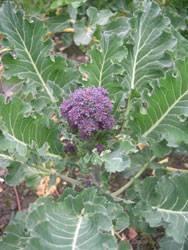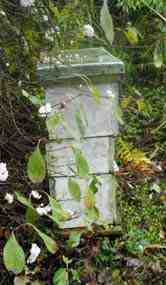Home grown Purple Sprouting broccoli
Posted by Fiona Nevile in Vegetables | 79 comments
Purple sprouting broccoli is easy to grow
The only problem with this vegetable is that it takes a year to mature. The seeds are planted towards the end of April and the long-ish wait puts people off. I reckon most people plant it, loose the seed packet and when it is not producing florets in the autumn the plants are hoiked out and thrown into the compost bin. It has the reputation of being a difficult vegetable. It is easy. Best germinated and grown on before planting out, it requires very little attention. It attracts the cabbage white butterfly and once you have dealt with this it is basically plain sailing until the harvest in the Spring. The only problem is that you don’t have enough.
To get a decent harvest, with many forays down the garden trug in hand, you need at least twelve plants and these take up quite a bit of space (2′-3′ apart 2.5′- 3.5′ between rows). The cropping season is short (four weeks), but you can extend this by harvesting regularly and growing early and late varieties. Then you can feast from March until well into May.
Despite these drawbacks I wouldn’t dream of not growing purple sprouting broccoli. At the moment we foster John Coe’s donated plants (mid season). They can be blanched and frozen, which I think I might do this year.
Broccoli is a cut and come again vegetable. The more you crop the more it produces. We didn’t twig this the first year and the season was so short that even the optimistic Danny was a bit disappointed.
The purple bobbles on the florets are in fact buds. If you leave them on the plant they will open into tiny flowers and the plant will not produce any more florets.
It’s one of the most flavoursome of vegetables. It stands beside asparagus and globe artichokes in my book. But at this time of year it is the first tasty, fresh surprise. Rushed from the kitchen garden to simmering saucepan, it’s a delight. I’m not keen on loads of veg but I love these tasty heads in a stir fry or snuggled beside slices of one of Danny’s superb Sunday roasts. It’s also heartening to see the plants standing stoically throughout the winter when most of the kitchen garden is bare.
It was so dry last summer that our purple sprouting broccoli went in very late (end of August). The plants are not nearly as big as last year. A couple of weeks ago they showed no signs of sprouting when John Coe and I examined them. This morning I spotted the first purple heads as I nipped past to open the greenhouse door.
I rushed back to the house to trumpet the news. Danny was shaving and gave the sort of resonant shriek that should always herald the arrival of this wonderful vegetable.
White sprouting broccoli is worth growing too. It has a more delicate taste than the purple but is less hardy.
Unwins has a good PSB variety available here.
Also Thompson and Morgan are always worth checking out as they stock several varieties including the white one.
Leave a reply






I have grown this in my obliging parents garden for the first time, having no idea what to expect as none of the regular gardening books actually show you what the plant is supposed to look like, just close up’s of the heads. So after sowing some in a pot and then growing on the plants in pots until they were about 8″ I planted them out in rows, but looking at the spacing after the summer growth I think it is best to give them at least a couple of feet diameter to grow as mine ended up quite bunched together. I staked them, and then staked them again after they got over a metre high. The highest plant is now over 5ft!I am told that mine are unusually huge by another gardner who happened to see them!
They were plagued with white caterpillar over the summer, which meant many evenings of squash-the-bugs patrol but the plants survived ok and withstood the winter well. So, a year later and still no heads, I was wondering if all my hard work had come to nothing…
But a month ago the first heads DID start to appear, and yesterday I ate my first heads for dinner and they were lovely. Well worth the effort. But they do take up a lot of space for a long time if you haven’t got much room in your plot. I recommend netting your crop to avoid the dreaded cabbage white butterflies.
I have 15 plants which are now cropping, my friends and neighbours will be getting lots I think!
Tip: steaming seems to take a lot of the colour out, I have been told that boiling in very hot water with a dash of vinegar for a just a couple of mins should help preserve it.
I’ve heard the plants last for more than one year, that is after the first harvest. Is this true?
Mary
Hi Tom
Loads of my clients plant this, throe away the seed packet and dig up the plants after four or five months.
Once the baby plants are in the ground (July in the UK) they will not harvest until April the following year.
The more florets that you pluck the more will grow. Just don’t let them go to seed and flower as this is curtains for a plant. If you are diligent they can crop for over six weeks.
relief! I planted a whole bunch of this stuff on my farm to try out, was about to give up! Guess I’ll give it some more time was beginning to wonder though, its going on 5 months for the first batch, the plants are beautiful but no florets, the pack said 60-70 days, guess it should have read 6-7 months! Cheers from Maui
hi. its the first time ive grown p/s/b/ do i cut off the top (flower) its not flowerd yet but there on top of the plant(buds) we have around 20
plants your advice would be most grateful thank you martin
I’m growing this for the first time this year and looking forward to the purple sprouts in Spring. Is it possible to eat some of the leaves while we’re waiting or are they too bitter? My veg patch is tiny and there’s an awful lot of greenery going to waste at present.
Hi,
I have had the same problem with the caterpillars
strippig my PSB bare! Does anyone know if it’s worth leaving the plants in the ground or should I pull them up?
I have been very proud of how well my purple sprouting has been doing and was already awaiting the first taste next spring however I have come home from holiday to find every single one of my plants (including my Kale and Sprouts) completely stripped bare by caterpillars! Not a leaf left in sight! Is this the end of these plants (i.e. better luck next year) or will they recover if I eradicate the little beasties!!!
Regards
Harriet
Hi Oionsargey,
Cover the plants with fine mesh netting to keep out the white butterfly. I found that staking each plant very important…they tend to grow and grow with very large leaves which makes them top heavy and prone to keeling over….worth all the trouble even though they have the same gestation period as an elephant !!.
Regards,
Patrick Arthur
Hi Oionsargey
I try to be organic and I spray with soapy water when the eggs are laid on the plants.It usually does the trick.
You can try spraying with a systemic insecticide (non organic) or covering the crop with thin white gardening fleece.